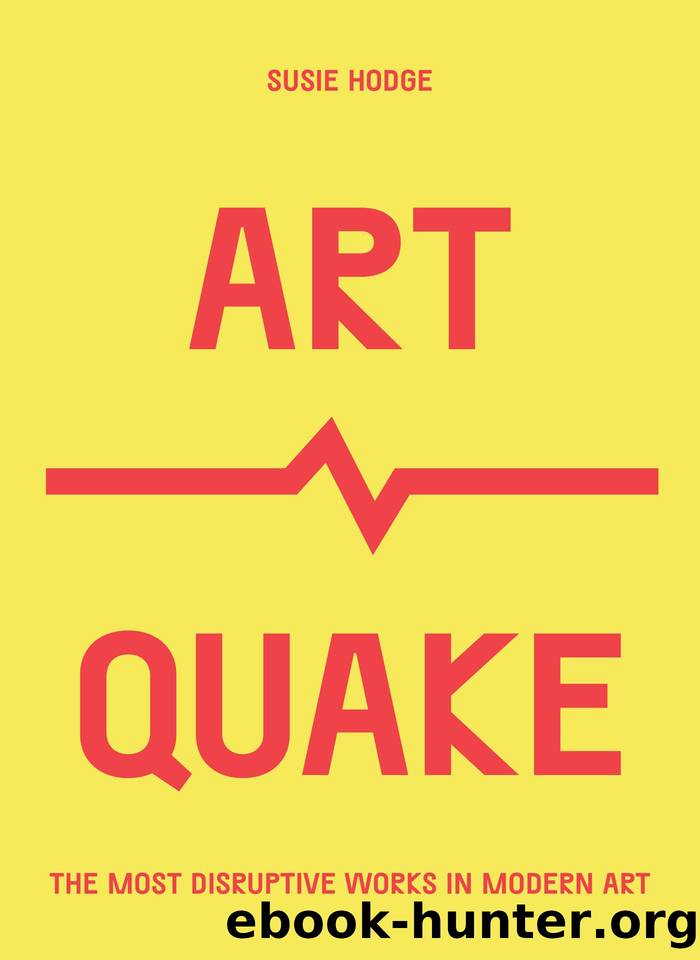ArtQuake: The Most Disruptive Works in Modern Art by Susie Hodge

Author:Susie Hodge [Hodge, Susie]
Language: eng
Format: epub
Tags: art, history, Modern (Late 19th Century to 1945), Individual Artists, General, popular culture, Social Science, Monographs
ISBN: 9780711254770
Google: r6cSEAAAQBAJ
Publisher: Frances Lincoln
Published: 2021-10-26T00:16:49.946523+00:00
UNEXPECTED ABSURDITY
UNTITLED ANTHROPOMETRY (ANT 100), YVES KLEIN
1960
During the early 1960s, Yves Klein (1928â62) used naked women to make his Anthropometry paintings, which were produced as elaborate performances in front of an audience. Both of Kleinâs parents were painters, and many of his early paintings were created using single colours. By the late 1950s, these monochrome works were almost exclusively in a deep, rich ultramarine that he eventually patented as International Klein Blue (IKB). As a devout Catholic, Klein associated the colour blue with spirituality and wisdom; in Christianity, blue symbolises heaven, eternity and truth and in Christian art, the Virgin Mary is customarily shown wearing blue, often made from the expensive pigment lapis lazuli, reflecting her role as the Queen of Heaven. Klein used IKB in almost all his work, from performance and installation to sculpture and painting.
Marking a shift from painting being something that happens with a brush, Kleinâs Anthropometry events influenced the painting and Performance art that followed. While his first Anthropometry paintings were created, an audience dressed in formal evening wear watched and blue cocktails were served. In a bow tie and black dinner jacket, Klein conducted a ten-piece orchestra in his personal composition of The Monotone Symphony, which he had written in 1949. It was a single continuous note played for twenty minutes, followed by twenty minutes of silence. When the music began, Klein conducted three naked female models to roll in the IKB paint that had been placed on giant pieces of paper on the wall and floor area, opposite the orchestra. When the music stopped, the women pressed or laid themselves on the paper, or were dragged across, creating imprints of parts of their bodies. Klein called them âliving brushesâ, and treated them as collaborators in his work.
Download
This site does not store any files on its server. We only index and link to content provided by other sites. Please contact the content providers to delete copyright contents if any and email us, we'll remove relevant links or contents immediately.
Kathy Andrews Collection by Kathy Andrews(11706)
The remains of the day by Kazuo Ishiguro(8787)
Paper Towns by Green John(5063)
Spare by Prince Harry The Duke of Sussex(5052)
The Body: A Guide for Occupants by Bill Bryson(4950)
Industrial Automation from Scratch: A hands-on guide to using sensors, actuators, PLCs, HMIs, and SCADA to automate industrial processes by Olushola Akande(4910)
Machine Learning at Scale with H2O by Gregory Keys | David Whiting(4101)
Be in a Treehouse by Pete Nelson(3922)
Never by Ken Follett(3760)
Harry Potter and the Goblet Of Fire by J.K. Rowling(3758)
Goodbye Paradise(3709)
Into Thin Air by Jon Krakauer(3288)
The Remains of the Day by Kazuo Ishiguro(3279)
The Cellar by Natasha Preston(3241)
The Genius of Japanese Carpentry by Azby Brown(3208)
Fairy Tale by Stephen King(3192)
120 Days of Sodom by Marquis de Sade(3160)
The Man Who Died Twice by Richard Osman(2977)
Drawing Shortcuts: Developing Quick Drawing Skills Using Today's Technology by Leggitt Jim(2974)
